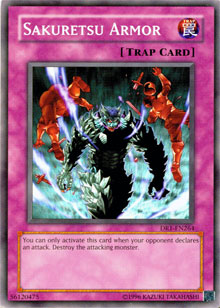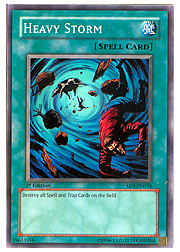If you spend much time reading online forums or hanging around listening to the veteran players at your local card shop, you’ve probably heard the term “card exchange.” It’s usually accompanied by a flurry of ones—“1 for 1,” “+1,” “-1,” and so forth. It’s an important concept to understand if you want to improve as a deckbuilder and a duelist. If you’ve been playing for a while, you’ve probably already got an instinctive understanding of this, but I’m going to lay it out in “academic” terms.
At the beginning of the duel, you and your opponent each begin with five cards in your hands. You’ve each got a “card presence” of five. Your “card presence” includes all of the cards you control, both cards in your hand and cards on the field. It doesn’t include the cards in your graveyard or cards that have been removed from play. For most purposes (barring recursion), those cards are considered “dead” cards. Give yourself one point for each card in your hand and on the field, and you’ve got your overall card presence.
Your turn begins, and what do you do? Draw another card! Add that, and your card presence goes from five to six. Easy! Each time you draw a card, you gain plus-one card presence. Logically, whenever a card leaves your hand and field, whether it’s discarded, sent to the graveyard, or removed from play, you lose one from your card presence. Tributing a card, using a spell or trap, discarding a card as a cost, or losing a card through destruction all count as minus-one to your total card presence.
Setting a card or summoning a monster doesn’t count as minus-one card presence, because that card is still part of your overall card presence. It’s just left your hand and moved to the field. It’s still there and it can be used, so your total presence doesn’t change at all. It won’t count as plus-one card presence, either—it’s just changing places.
In a duel, would you rather have a sizeable card presence, or would you prefer to have an empty hand and a clear field? Of course, you want to have as many cards as possible, to give you plenty of options in the duel. However, you can’t hold an infinite amount of cards in your hand, there’s only so much room on the field, and you can’t count on winning a match by sitting there and doing nothing. Obviously, you have to use your cards, even though you’ll eventually lose card presence because of it.
The trick to managing your card resources is to consider the exchanges you make. In other words, you can conserve your card presence by ensuring that your minus-ones don’t outpace your opponent’s. Let’s say that on your turn, after drawing your card (remember, you’ve got a card presence of six) you summon a monster and set a spell or trap. Your card presence hasn’t changed. Your opponent takes his turn, draws his card (giving him a card presence of six), sets two spells or traps, and then ends his turn. You’ve both still got a card presence of six.
 You draw a card, bringing yourself up to seven, and attack with your monster, but your opponent responds with Sakuretsu Armor. Ouch! Your monster goes to the graveyard, you take a minus-one, and then your opponent takes a minus-one as Sakuretsu Armor is sent to the graveyard. You’ve each lost one card, so a “one-for-one exchange” has taken place.
You draw a card, bringing yourself up to seven, and attack with your monster, but your opponent responds with Sakuretsu Armor. Ouch! Your monster goes to the graveyard, you take a minus-one, and then your opponent takes a minus-one as Sakuretsu Armor is sent to the graveyard. You’ve each lost one card, so a “one-for-one exchange” has taken place.
You’ll see a lot of one-for-one exchanges in the average duel, like Mystical Space Typhoon, two Cyber Dragons taking each other out, Sakuretsu Armor in response to an attack, and more. In fact, cards like Smashing Ground, Sakuretsu Armor, and Widespread Ruin are widely referred to as “one-for-ones.”
Okay, so some cards leave your control, other cards come under your control, and the numbers flip back and forth. How does that translate into something of value to the average player? Well, if you understand this relatively simple system, you can start evaluating your potential moves from a mathematical standpoint. If you love math, this will be fun for you. If you hate math, don’t worry, it’s not as mathematical as you might fear. Just keep reading.
To start, let’s set out some basic laws of the system. First, one-for-one exchanges are mathematically neutral. Neither player gains or loses an advantage here. Second, any move that results in one player gaining card presence is good for that player. Third, any move that results in one player losing more card presence than his or her opponent is bad for the player who’s losing. If we accept these general rules, we can evaluate decisions in simplistic, yet beneficial ways.
For instance, let’s say you have Heavy Storm in hand. The opponent controls one set monster and a set card in his or her spell and trap zone. You don’t have anything on the field yet, but you do have a monster you could summon and attack with this turn.
If you were to activate Heavy Storm, you would likely destroy your opponent’s set spell or trap. It would be sent to the graveyard, as would your Heavy Storm. That’s a one-for-one exchange, and while it would allow your in-hand monster to attack this turn without fear of Sakuretsu Armor, you aren’t gaining card advantage from Heavy Storm itself. You’re losing a spell, the opponent is losing a spell or trap, and who knows what could happen once you initiate battle. To some extent, this one-for-one exchange should be viewed as a risky move. Heavy Storm can potentially generate card advantage, but in this example, you’re disregarding that opportunity in favor of improving the success of your attack.
 However, let’s say that the situation is a bit different. Perhaps your opponent still controlled a set monster, but this time he had two set spells or traps. If you activate Heavy Storm in this situation, you’ll lose one card (the Storm), but your opponent will lose two! That’s a two-for-one exchange, and it nets you a single card of advantage. Now, regardless of what happens in battle, you can rest easy, knowing that you deprived your opponent of two of his options in exchange for just one of yours.
However, let’s say that the situation is a bit different. Perhaps your opponent still controlled a set monster, but this time he had two set spells or traps. If you activate Heavy Storm in this situation, you’ll lose one card (the Storm), but your opponent will lose two! That’s a two-for-one exchange, and it nets you a single card of advantage. Now, regardless of what happens in battle, you can rest easy, knowing that you deprived your opponent of two of his options in exchange for just one of yours.
Seems simple, huh? Well, it is and it isn’t. While this basic mathematic philosophy will generally steer you in the right direction, you’ll always need to interpret the raw numbers carefully and balance the math with reality. For instance, what if your opponent’s two set spell or trap cards were Scapegoat and Jar of Greed? Your opponent could chain both cards, claiming four Sheep tokens and drawing a card from the Jar. He doesn’t really lose anything in this scenario. Jar of Greed replaces itself, and Scapegoat is technically a minus-one because it goes to the graveyard, but it does produce four tokens. Meanwhile, you lose your Heavy Storm, which is definitely a minus-one in anybody’s books.
You can see that while the system itself is simple to understand, applying it successfully will take experience and quick thinking. Let’s go back a bit to the one-for-one trades that we were talking about earlier. It seems like the most basic of math, but you need to remember that not all the “ones” in a one-for-one trade are created equal. Remember the Sakuretsu Armor scenario we touched on earlier? One player attacks with a monster while the other destroys it with Sakuretsu Armor, creating a one-for-one exchange. It’s a bit more sophisticated than that, though, because a trap and a monster have inherent differences. After all, while you can set as many traps as you wish per turn, I can only normal summon one monster per turn. You’ve traded what is, in a sense, an unlimited resource (a trap) for my limited one (my monster). I can’t just summon that monster and try to attack again this turn. The card numbers may have been traded equally, but the card resources or “values” have not.
That’s what all those “+1s” and “-1s” mean. Now that you’ve got a basic understanding of the system, you can start applying it to your dueling experiences. Before you make a move, go ahead and ask yourself how it works out in terms of card presence. Once you can correctly analyze the moves you’re making, try looking ahead to calculate card presence in future turns. Sure, peeling off some of your opponent’s life points with Don Zaloog gives him or her a harsh minus-one, but is it really worth it if Don will get squashed a turn later, and you take the minus-one of its destruction? These decisions can get very tricky.
If you can master this technique, you’ll be able to take your duels to whole new levels. You’ll win more frequently, and when you lose, you’ll often understand why you lost. You’ll become a better player, and your dueling experience will be far more rewarding. Do you remember the tactics article I put up a few weeks ago? Go back and reread it, applying what you’ve learned here today, and you’ll probably gain some new insight. Here’s to more wins!